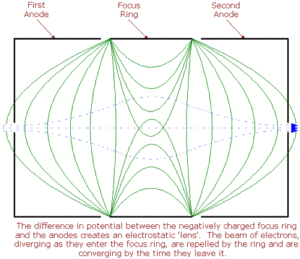There are parts of the CRT that control the production, flow, acceleration and direction of the tube’s electron beam but leave its shape unaltered.
As the electrons accelerate towards the screen, they tend to diverge, as they all have a similar negative charge. If this divergence were to continue, the beam’s diameter when it reached the faceplate would be much wider than a single pixel, so some form of focusing device is needed to concentrate the beam. Three methods of achieving this beam-focusing have been used at various times: gas, where a small quantity of a gas, such as argon or mercury vapour, is introduced into the CRT; electromagnetic, where the beam is controlled in a similar manner to that employed by the deflection yoke ; and electrostatic, which uses the same principles as do the control grid and anode .
Looking at the deflection yoke , we can see that both electromagnetic and the faster electrostatic deflection have been used in CRTs but that electrostatic deflection was too weak to control the high energy beams used in TVs and colour monitors. When it comes to beam-focusing, however, the focusing electrodes mounted in the CRT neck are much closer to the beam, have to exert less influence over a smaller area and are operating in a region where the beam energy is lower than where deflection takes place. Colour monitor CRTs use electrostatic focusing, but the high brightness monochrome CRTs used for projection often use electromagnetic focusing.

